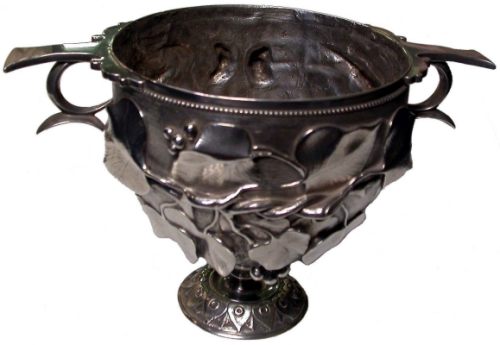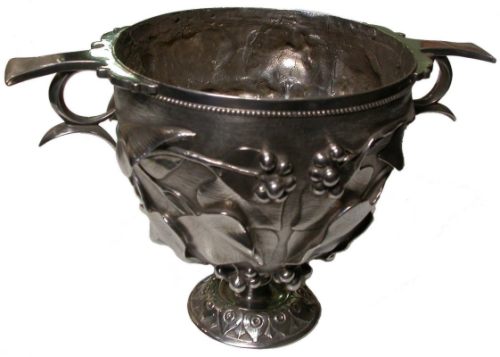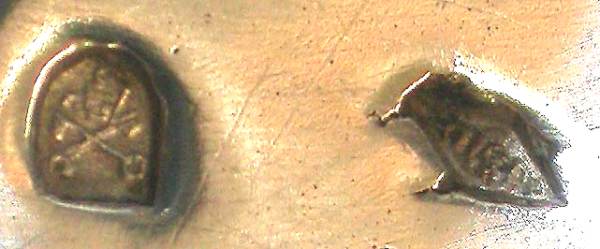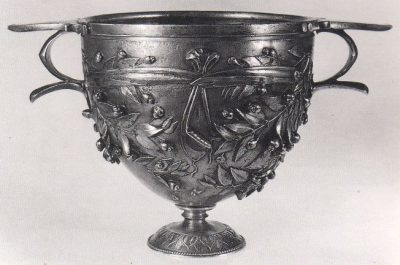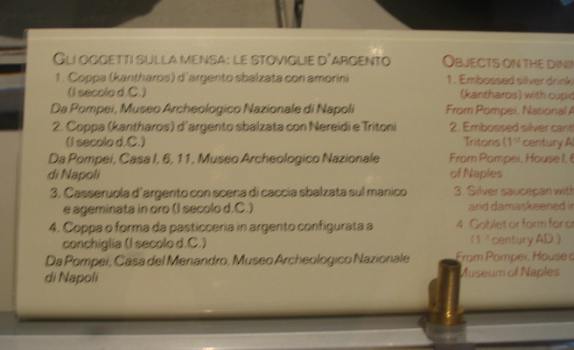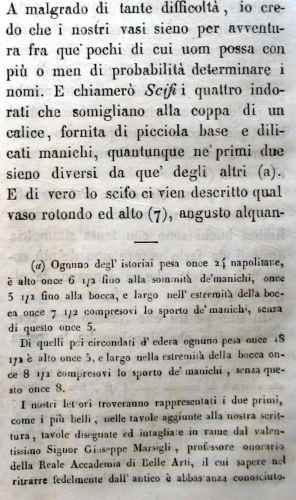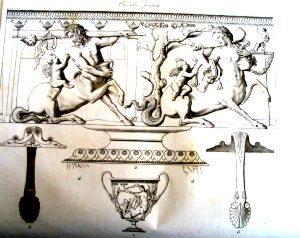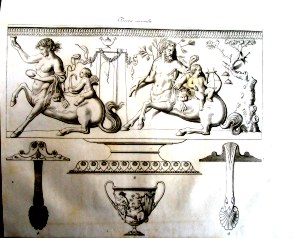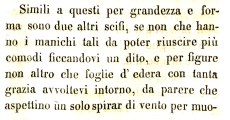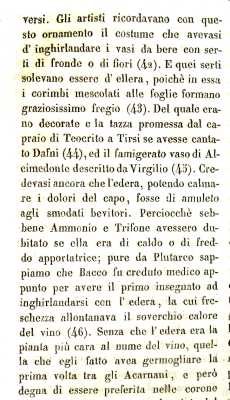|
|
article # 40 |
home |
next |
previous |
(click on photos to enlarge)A SILVER CUP FROM THE ANCIENT ROME
|
hallmarks |
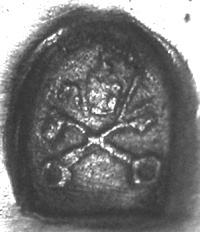 |
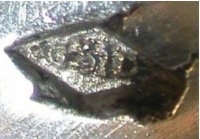 |
Papal State: hallmark with crossed keys and mitre |
hallmark: G??D into a lozenge |
There is an association of the decoration with the purpose of the
cup as ivy was dedicated to Bacchus, who is often depicted wearing a wreath of ivy and grapevines
that were supposed to prevent intoxication.
Untried is the receipe, to overcome the effects of intoxication, being a handful of bruised ivy
leaves gently boiled in wine and drunk, an alternative is moderation.
Fred Sinfield
endnotes
(1) A nobleman in the 18th and 19th century completed his education with a
period of European travel: the so-called 'Grand Tour'. By undertaking
the Tour, young men learned about the politics, culture, and art of
neighboring lands.
The primary destination of the 'Grand Tour' was Italy, with its heritage
of ancient Roman monuments.
18th and 19th century taste revered the art and culture of the ancients.
The British, in particular, were lured to Italy by their admiration of
antiquity and their desire to see firsthand such monuments of ancient
civilization as the Colosseum in Rome, and such wonders of nature as the
volcanic eruptions of Mount Vesuvius, near Naples, and its
archaeological excavations of Pompeii and Herculaneum.
Nothwithstanding the cup is a copy of an ancient Roman piece, this is an excellent
example of the 19th century silver workmanship.
So, I've tried to obtain a full identification of its hallmarks.
This was my result:
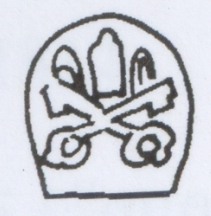 |
Papal State: mitre and crossed keys mark of small works. purity degree 889/1000, used from 1815 to September 20, 1870 (hallmark # 156: Argenti Italiani dell'Ottocento vol. 1- V.Donaver - R. Dabbene) |
The lozenge hallmark with letters and numbers inside is nearly unreadable.
This type of lozenge is a very common mark for Roman silversmiths of the 19th century. Some examples follow:
This list of silversmiths is from Argenti Italiani dell'Ottocento vol. 2°-
V.Donaver - R. Dabbene, but I believe that the mark of our cup belongs to no
one of these silversmiths.
So, I had another question needing a reply: what was in ancient times the name of these cups?
My first idea was that it was a 'kantharos',
similar to the cups seen some time ago in the exibition 'Convivium',
held in the 'Domus del Triclinium' in Ravenna (Italy).
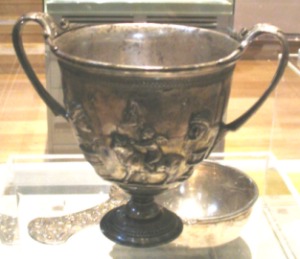 |
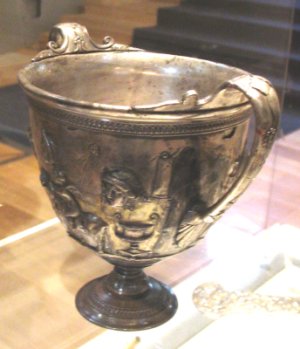 |
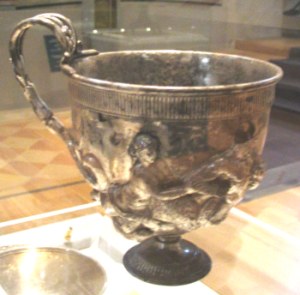 |
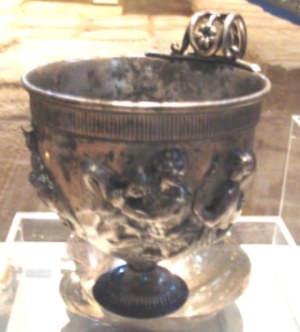 |
plate in the 'Convivium' exibition
|
Their look is very similar to Sinfield's cup, nevertheless the handles have a different shape.
So I decided to continue my researches.
I remembered buying a book in an antiquarian library 'ANNALI CIVILI DEL REGNO
DELLE DUE SICILIE' (Civil Annals of The Regno delle Due Sicilie),
printed in Naples in 1836, containing an article titled 'DI
QUATTORDICI VASI D'ARGENTO DISSOTTERATI IN POMPEI NEL MDCCCXXXV (1835)'. (About 14 silver vases
found in Pompeii in the year 1835)
 |
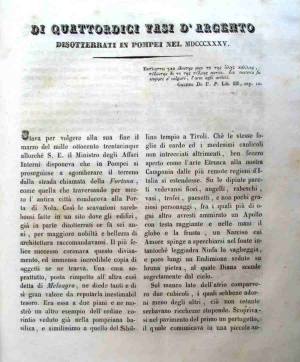 |
This article, signed B.*** Q.*** (B. Quaranta), contains the details of the finding and the description of the objects, and in an obsolete Italian language states:
Even if the description isn't fully correct (the vases with 'high handles' are two 'kantharos'),
the use of the term 'scifi' allowed to find the correct definition ('skyphos') to
attribute to the vases...
The correct definition of Fredric Sinfield's cup is 'skyphos' (scyphus), and, moreover, is
embossed with ivy wreaths as the cup found in 1835 in Pompeii.
I've found some other informations about 'kantharos' (cantharus) and 'skyphos' (scyphus) (note 2)
Kantharos (Cantharus)
Bronze, silver
Cup with tapering body or in the shape of a hemisphere, raised up on a high foot, with two slender
vertical handles, sometimes surmounting the rim. The body is often decorated with floral motifs or
figural scenes. The silver cantharus with Tritons and Nereids from Pompeii (note 3),
dating to the 1st century B.C., provided with a single, richly decorated handle, is an example of the
flourishing art of embossing in the age of Roman Republic. Similarly dated to the mid of the 1st century
B.C. are the canthari from Alesia (decorated with grapevines) and the two later
canthari, decorated with olive shoots, from the House of Menandro (with handles of
Hellenistic taste, unbound from the rim). The 'canthari' from the House of Menandro are decorated with
a rich embossing, the preferred technique for high value objects manufactured in the first part of
the Imperial Age.
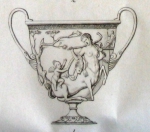 |
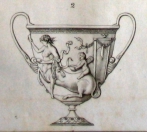 |
|
kantharos: embossed silver with Centaurs and Cherubs -
eng. by Giuseppe Marsigli
|
kantharos: embossed silver with Centaurs and Cherubs -
eng. by Giuseppe Marsigli
|
Skyphos (Scyphus)
Bronze, silver
Cup with oval body or in the shape of a hemisphere, with two ring handles along the rim and wide
and low foot. Few silver skyphos are known, while there's a great availability of ceramic skyphos.
Sometimes they have large measures, like the silver skyphos with mythological scenes from Hoby,
measuring 21 cm. of diameter. Often they are decorated with mythological subjects (i.e. episodes
of the life of Bacchus on the skyphos from the House of Menandro), with landscapes or with
historical subjects (like the two skyphos from the treasury of Boscoreale) (note 4).
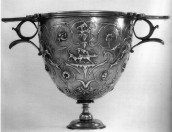 |
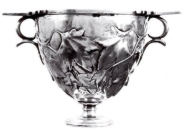 |
|
skyphos: embossed silver with animals and floral motifs
|
skyphos: embossed silver with plane tree branches
|
I do not know if the unidentified Roman silversmith of the 19th century took
his inspiration from the skyphos discovered in Pompeii in 1835
(likely, in the Museo Archeologico Nazionale of Naples) or from another
skyphos in a museum of Rome. Anyway this 19th century reproduction was of great assistance in
broadening my knowledge of Roman silversmithing of two thousands years ago.
Giorgio Busetto
endnotes
(1) the 'oncia napoletana' (ounce of Naples) was a term used to measure both weight and
length. Their equivalences are:
weight: 1 ounce = gr. 26.72 - length: 1 ounce = cm. 2.79
The measures of the vases are
vases with high handles
weight gr. 641.2
length (high): at handles cm. 18.1 and cm. 15.3 at the rim
length (wide): at the handle cm. 20.9 and cm. 13.9 at the mouth
vases with ivy leaves
weight gr. 494.3
length: (high): cm. 13.9
length (wide): at the handle cm. 23.7 and cm. 22.3 at the mouth
The measures supplied by B. Quaranta look largely approximate, as these measures are not coherent
with those obtained examining the images of the same vases in the engraving of Giuseppe
Marsigli.
(2) from: Ministero dei Beni Culturali - Vocabolario settoriale
campo OGTD della scheda RA a cura di L.M. Vigna: Contenitori in metallo e leghe metalliche
(3) likely, this is the cup with Nereids and Tritons that I've photographed in the exibition in
Ravenna
(4) the 'Treasure of Boscoreale' was discovered in 1895 in a Roman villa of Boscoreale (near Pompeii),
buried by the volcanic eruptions of Mount Vesuvius in 79 A.D.
The Baron Rothschild donated to the Louvre Museum 109 pieces of silverware of Boscoreale
provenance.

